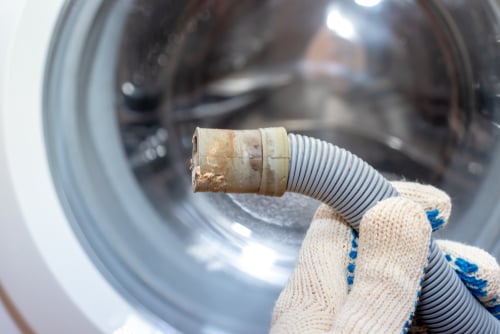The next time your garbage disposal or dishwasher gets backed up, you'll be grateful the air gap works properly. Why? It prevents food from going into the faucet.
It’s possible you’ve never heard of a dishwasher air gap, but it plays an important role in keeping your dishwasher operating properly and protecting your family's health.
So, what exactly does a dishwasher air gap do? Put simply, it prevents drain water from backing up into your dishwasher and contaminating your freshly washed dishes with dirty drain water.
How an Air Gap Works
Picture your kitchen faucet and sink. If the sink drain becomes clogged and water backs up into the sink, that water can't reach the faucet outlet because of the “air gap” separating the two. The faucet outlet is always higher than the rim of the sink, which creates an air gap between the two. The backed-up sink water won’t reach the faucet outlet and contaminate your water supply.
The same principle applies to your dishwasher air gap. The device is usually a small cylinder sitting on your cabinet top near the sink and faucet. As your dishwasher cleans your dishes, the wastewater is pumped out of the dishwasher and carried by a hose to the air gap.
Like your faucet opening above the sink, the outlet from the dishwasher hose in the air gap is higher than the opening to the drain hose leading away from the device. As with the faucet and the sink, an air gap separates the two hoses.
If everything works properly, the dishwasher pumps wastewater to the air gap where it’s moved away by the drain hose to the garbage disposal. The air gap separating the openings of the two hoses normally prevents wastewater from backing up and contaminating your freshly washed dishes. You can find an illustration of a dishwasher air gap here.
Things do not always work as they should, however, and a clogged air gap can create a huge mess in your kitchen, as shown in this video.
If water is flowing or gushing out of the air gap, there are some DIY solutions you can try to correct the problem.
- One involves a roll of paper towels. Remove the cover of the air gap, place the paper towel tube over the hose openings, and blow into the air gap. This may remove food particles interfering with the normal water flow.
- If this technique doesn’t work, use a long-handled bottle brush to dislodge food particles or other debris that may have jammed the drain hose.
- If either your garbage disposal or dishwasher has been recently installed, it’s possible the installer forgot to remove the “knockout plug" on the disposal unit. To fix this, detach the hose linking the air gap drain hose to the disposal. Take a hammer and screwdriver and tap the knockout plug that’s preventing water from draining into the disposal. Then reconnect the drain hose to the disposal. Finally, unplug the disposal, reach inside it, and remove the knockout plug.
If none of these tricks work, you may need to have a plumber snake out your drain lines to remove debris you can’t reach.
Was this article helpful?






